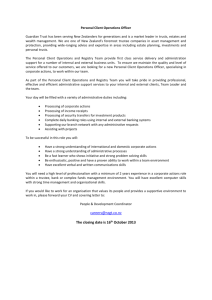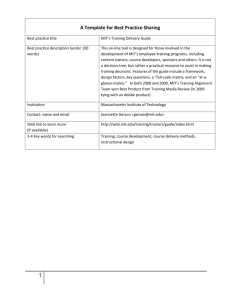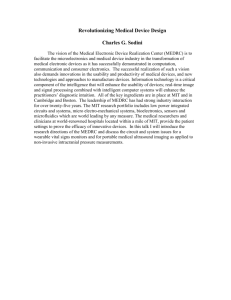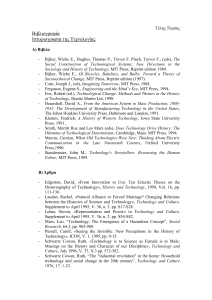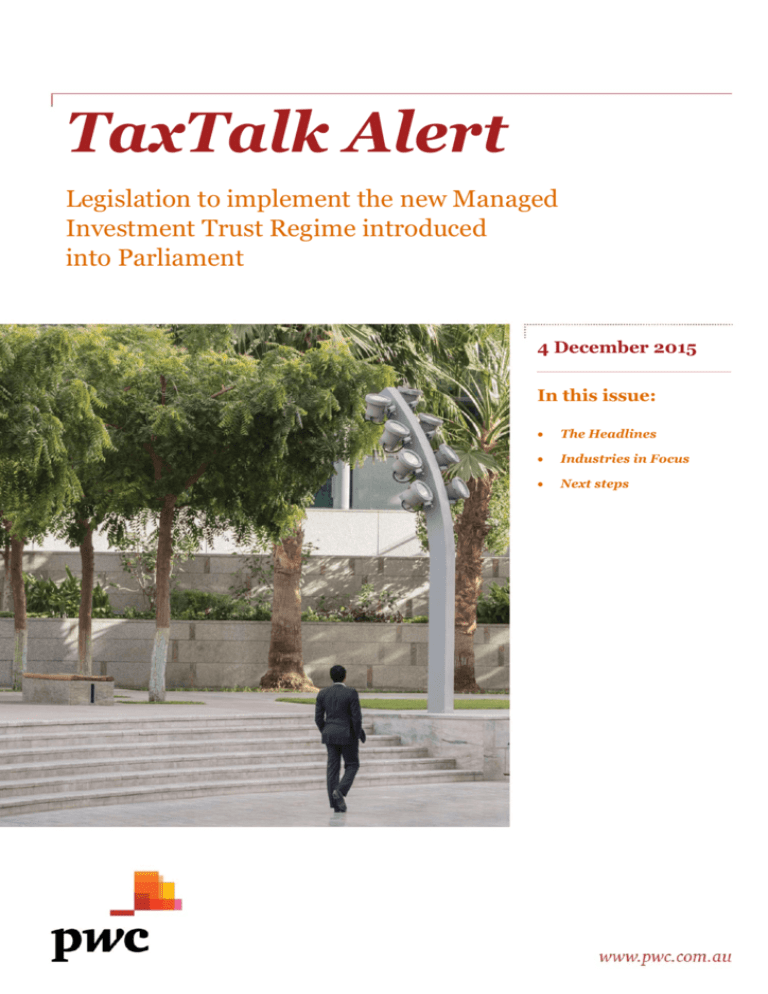
TaxTalk Alert
Legislation to implement the new Managed
Investment Trust Regime introduced
into Parliament
4 December 2015
In this issue:
The Headlines
Industries in Focus
Next steps
The Headlines
On 3 December 2015, Tax Laws Amendment (New Tax System for Managed
Investment Trusts) Bill 2015 and related Bills were introduced into Federal
Parliament. These Bills contain the legislation to implement the new tax regime for
managed investment trusts (MITs) and a number of related amendments. As
Federal Parliament is now on break for the summer, it is likely that these Bills will
be debated and passed in the autumn 2016 sitting which commences on 2 February
2016.
In this update, we highlight:
the main changes to the law since the public release of exposure draft legislation
in April this year,
the key features of the new MIT regime and other related amendments,
key issues for the investment management, infrastructure and real estate
industries, and
next steps which should be considered.
What has changed since the April 2015
Exposure Draft?
As foreshadowed soon after the last public release of legislation, the new MIT
regime will now apply to income years commencing on or after 1 July 2016.
Eligible MITs will be able to elect to become an Attribution MIT (AMIT) by
irrevocable choice. An ability to ‘opt in’ early (for income years commencing on
or after 1 July 2015) is available.
There have been revisions to the definition of ‘clearly defined interests’ (the
central requirement for AMIT status), including safe harbours.
The proposal to ‘uplift’ net ‘unders’ above a safe harbour threshold has been
removed. However, penalties may still apply to any individual ‘under’ or ‘over’
arising from recklessness or intentional disregard of the tax law (see the table
on page 5).
The rules no longer prescribe the specific tax components to be attributed to
members beyond the broad categories of income, exempt income, NANE
income and tax offsets.
All changes to the definition of ‘qualified investor’ for the purposes of the MIT
widely held test will now apply retrospectively from 1 July 2014. An issue arising
from the previous draft law regarding the ability to invest into a MIT via certain
limited partnerships has been rectified.
A statutory right of indemnity has been introduced for trustees and custodians
to recover withholding tax in the event that the cash ultimately distributed is
less than the withholding obligation that the trustee or custodian has funded.
In respect of withholding tax, the rule that is currently afforded to foreign
pension funds has been extended to all foreign trustees provided the MIT
making the fund payment is an AMIT, such that the foreign trustee becomes the
final taxpayer.
2
The non-arm’s length income rule will generally take effect for income years
commencing on or after 1 July 2016 and will apply to all MITs, not just AMITs.
The transitional period to allow MITs to restructure existing arrangements has
been extended by one year to cover income derived before the start of the 201819 income year.
The rate of tax applicable to non-arm’s length income has been reduced from
47% to 30%. The rule requires the Commissioner to make a determination
rather than it being self-executing.
The changes to Division 6B and 6C will now apply one year later (to income
years commencing on or after 1 July 2016) and trusts that cease to be Division
6C or Division 6B trusts will be able to pass out franking credits to unitholders
for a limited period.
In addition, the Australian Taxation Office (ATO) has published detailed draft
guidance notes (called Law Companion Guidelines) in respect of key aspects of the
proposed regime (as listed below). These will be integral to determining the impact
of the provisions.
-
Non-arm’s length income rule,
-
Cost base adjustments and associated transitional rules,
-
Character flow-through for AMITs,
-
Choice to treat separate classes as separate AMITs,
-
Clearly defined rights,
-
Rules for working out trust components – allocation of deductions,
-
Attribution on a fair and reasonable basis,
-
MIT widely held tests – wholly owned entity of an Australian government
agency,
-
Administrative penalties for recklessness or intentional disregard of the tax
law, and
-
Trustee shortfall taxation.
TaxTalk Alert
PwC
3
What are the key features of the new MIT Regime?
There will now broadly be three types of MITs for tax purposes:
Ordinary MIT: eligible to make the MIT capital account election.
Withholding MIT: has the same base outcomes as an ordinary MIT but with the
benefit of concessional withholding provisions in respect of certain fund
payments because it has a substantial proportion of its investment management
activities in Australia.
Attribution MIT: has the same base outcomes as an ordinary MIT, however it is
subject to the new AMIT provisions. An AMIT may or may not be a withholding
MIT.
We have discussed the application of the new AMIT provisions below.
What is an AMIT?
An AMIT is a managed investment trust where the interests of members are
‘clearly defined’ and the trustee has made an irrevocable choice for the regime to
apply. A trust can opt-in to the regime at any time after the start dates discussed
earlier; however, the time at which a trust adopts the regime may impact its
ability to access some of the transitional provisions.
A MIT that is a registered scheme will be deemed to have clearly defined
interests. For unregistered schemes, the rights to income and capital arising
from each of the units or interests in the trust will need to be the same at all
times in the relevant income year for the clearly defined requirement to be met
(disregarding a number of factors such as the imposition of different fees, issue
and redemption prices etc.).
The trustee has the option to recognise individual classes of multi-class trusts as
distinct AMITs. This will generally enable the tax position of classes to be kept
separate.
Attribution provisions
The allocation of trust components to the members of an AMIT will be based on
an ‘attribution’ which must be made on a fair and reasonable basis in
accordance with the trust deed, rather than based on present entitlement to
distributable income.
AMITs will be required by law to provide members with annual tax statements
(‘AMMA statements’) within three months of the end of the income year to
facilitate the attribution process. AMMA statements can be re-issued up to four
years after the end of the income year. There are new reporting requirements
imposed, such as providing cost base information to members.
Streaming of components based upon the tax characteristics of members is not
permitted, but other examples are provided in the legislation (and ATO
Guidance) of trustee powers considered acceptable. For example, where the
constituent documents give the trustee the power to direct an amount arising
from the sale of an asset to a particular member if the member redeems its
interests in the AMIT and the streaming is done to fund the redemption.
Members of an AMIT will be taxed on the parts of the AMIT's trust components
that are attributed to them as if they derived those amounts in their own right
and in the same circumstances as the AMIT. Consequently, non-resident
members will be unable to offset non-Taxable Australian Property (TAP) losses
against capital gains derived in respect of TAP.
TaxTalk Alert
PwC
4
Unders and overs
The existing treatment of unders and overs is now both modified and codified in
the law. They will be determined on a component by component basis and
generally carried forward and dealt with in the components of the income year
of ‘discovery’. There is generally a four year time limit on the requirement to
‘discover’ unders and overs measured from the time that the tax calculations
supporting the latest AMMA statement issued in respect of an income year were
prepared.
As an alternative to recognising unders and overs, an AMIT could re-issue
AMMA statements.
A transitional rule may apply to allow unders and overs relating to income years
prior to the trust becoming an AMIT to be recognised in a discovery year after
the trust opts into the regime.
If a trust ceases to be an AMIT it must continue to account for any unders or
overs, arising in respect of the period it was an AMIT, that it discovers for a four
year period in its taxable income.
Penalty regime
An administrative penalty may apply to the trustee of an AMIT where any
individual under or over is considered to arise due to the intentional disregard
of a taxation law or recklessness by the trustee as to the operation of a taxation
law. The amount of the penalty would be determined as follows:
Reason for
under or over
Intentional
disregard of a tax
law
Recklessness as
to the operation
of a tax law
Under of assessable,
exempt or NANE income
OR
Over of tax offset
Top marginal rate (plus
applicable levies) multiplied by
75% of the under or over, as
applicable
Top marginal rate (plus
applicable levies) multiplied by
50% of the under or over, as
applicable
Over of assessable, exempt or
NANE income
OR
Under of tax offset
Greater of:
(a) Top marginal rate (plus applicable
levies) multiplied by 30% of the under
or over, as applicable; and
(b) 60 penalty units*
Greater of:
(a) Top marginal rate (plus applicable
levies) multiplied by 20% of the under
or over, as applicable; and
(b) 40 penalty units*
* A penalty unit is currently $180.
The existing penalty provisions in the Taxation Administration Act 1953
provide the Commissioner of Taxation with the ability to remit the penalties
outlined above.
A tax liability may be imposed upon the trustee of an AMIT where there has
been an under attribution of income or over attribution of tax offsets to
members. The Commissioner may remit these penalties, if for example, he is
satisfied that there has been no detriment to the Revenue.
Cost base adjustments and tax deferred distributions
In addition to downward cost base adjustments required under the current law,
members of AMITs will be entitled to make upward adjustments to the cost base
of their units in the AMIT where the distribution or money or property they
receive is less than their allocated share of the taxable trust components.
The tax treatment of tax deferred and tax free distributions made by an AMIT to
a member is clarified in relation to membership interests treated on both capital
and revenue account (i.e. that they reduce the tax cost of the interests, rather
than being treated as ordinary income). A transitional rule may apply to provide
this outcome in respect of such distributions made from 1 July 2011 onwards.
TaxTalk Alert
PwC
5
Withholding tax
Where an AMIT makes a fund payment to a foreign trustee, the foreign trustee
will be final taxpayer for withholding tax purposes. That is, the final withholding
liability will rest with the foreign trust and there is no tracing mechanism to
look-through to the ultimate investors. There is no corresponding change to the
withholding mechanism for other withholding MITs.
In cases where as a result of the operation of the attribution provisions, a
deemed payment made by a trustee or custodian to a foreign resident is not
accompanied by an actual cash payment, or if the cash payment is less than the
amount of the withholding obligation, the trustee or custodian continues to
have the obligation to pay the withholding tax and will have a corresponding
right to recover that amount from the foreign resident recipient.
Fixed trust status
An AMIT will be treated as a fixed trust for tax purposes. This will ensure that
AMITs are more easily able to carry forward and utilise tax losses, and flow
through franking credits to members.
The commercial application of these amendments is discussed further in Industries
in Focus below.
Other related amendments
Non-arm’s length rule
For income years commencing on or after 1 July 2016, the trustee of the MIT
will be liable to pay tax on any non-arm’s length income derived by the trust.
Tax will be levied at 30% on the portion that exceeds the arm’s length amount.
Interest income will not be subject to the non-arm’s length income rule if it is
within specified safe harbours, namely the benchmark rate or is less than 300
bps below the base interest rate.
There is a short transitional period (for amounts derived before the start of the
2018-19 income year under a scheme entered into by the MIT before 3
December 2015) to allow existing MITs to restructure their arrangements.
However, for trusts with a substituted accounting period, the transitional period
may be shorter. For example, a 31 December balancer may find that the
transitional period ends on 31 December 2017.
This rule only applies to non-arm’s length income - there is no equivalent rule
for deductions that are below the relevant arm’s length amount.
The ATO guidance will be critical in this area.
TaxTalk Alert
PwC
6
Revised definition of a MIT
The primary definition of ‘managed investment trust’ which is relevant for all
purposes of the tax law will be amended to:
-
expand, with effect for income years commencing on or after 1 July
2014, the list of qualifying entities to include foreign life insurance
companies, entities that are wholly owned by one or more qualified
investors and limited partnerships where all the limited partners are
qualifying investors and the general partner holds a 5% or less
interest. This is a welcome change which reflects commonly used
foreign ownership arrangements, and
-
increase the start-up concession period to a maximum of 2 years
(the year of formation and the following income year) from the
existing maximum of 18 months. This will give MITs additional time
to meet the widely held and closely held criteria. This change will
apply from the time that the AMIT provisions take effect.
Application of Division 6C and repeal of Division 6B
Under Division 6C of Part III the Income Tax Assessment Act 1936 (ITAA 1936),
a public unit trust that does not carry out a wholly eligible investment business
can be taxed in a similar manner to a company. The existing rule in Division 6C
which deems a trust to be a public unit trust where certain exempt entities and
superannuation funds hold 20% or more direct or indirect interests in the trust
will be repealed with effect for income years commencing on or after 1 July
2016. Transitional rules have been included to permit trusts that cease to be
subject to Division 6C to pass out franking credits to unitholders until 30 June
2018. However, the mechanics to allow a trust to pass the franking credits
through to unitholders will need to be carefully considered.
Division 6B of Part III of the ITAA 1936, which sought to tax corporate unit
trusts in a similar manner to companies, will be repealed with effect for income
years commencing on or after 1 July 2016. Transitional rules have been included
to permit trusts that cease to be subject to Division 6B to pass out franking
credits to unitholders until 30 June 2018. There has been a consequential
change to section 128FA of the ITAA 1936 to change the definition of public unit
trust to that contained in Division 6C, with some minor alterations.
TaxTalk Alert
PwC
7
Industries in Focus
Investment Management
The vast majority of funds in the investment management industry are MITs.
The trustees of these trusts will need to carefully consider how they will manage
the changes that the introduction of the AMIT regime will bring.
The modification and codification of industry practice around the treatment of
unders and overs is a key feature of the AMIT regime for the investment
management industry. It is unclear how trusts that do not become AMITs will
be entitled to manage these balances once the AMIT regime commences. This is
likely to be an important consideration in the decision to choose AMIT status.
There are other potential benefits such as:
– the flexibility afforded by attribution,
– deemed fixed trust status,
– multiclass treatment as separate AMITs, and
– upward cost base adjustments.
However, given the penalties that may be imposed upon the trustee under the
AMIT regime, it will be important that processes around the implementation
and subsequent administration of the system (such as year-end procedures) are
tightly managed to minimise risks.
Infrastructure
The extension of the non-arm’s length rule means that all MITs, regardless of
whether they fall within the new attribution tax regime, will need to reconsider
arrangements with related parties, including cross-staple loans, management
agreements, and rental and licensing arrangements. This is likely to lead to a
substantial increase in compliance costs. Taxpayers will need to undertake
appropriate economic analysis and document their positions in light of the
inherently subjective nature of arm’s length pricing analyses.
Trusts in the infrastructure industry will need to carefully consider the decision
to ‘opt in’ to the AMIT regime. There are likely to be benefits from breaking the
link between the cash distribution of the trust and the liability of unitholders in
respect of the taxable income of the trust, especially in the ‘lock-up’ phase of a
project, but this will need to be weighed against any additional compliance costs
under the new regime, and the risk of trust resettlements arising from
amendments that may be required to trust deeds to satisfy the conditions to be
an AMIT. With the extension of the non-arm’s length rule to all MITs, the
disadvantages of opting into the AMIT regime have significantly reduced.
The amendments to Division 6C to remove the ‘20% super fund’ rule is a
welcome change that should make it easier for infrastructure trusts to access
funding from complying superannuation entities without loss of flow-through
status. This, combined with the changes to the definition of qualifying investor
for the purposes of MIT classification, should make investment into
infrastructure MITs more attractive for both Australian and non-resident
investors.
8
Real Estate
A key feature of the new legislation is the extension of the definition of a
qualified investor to include entities that are wholly owned by one or more
qualified investors and limited partnerships where all the limited partners are
qualifying investors and the general partner holds a 5% or less interest.
This change more closely aligns Australia’s treatment of limited partnerships for
this purpose with other tax jurisdictions.
This will benefit foreign collective investment vehicles or multiple qualified
investors who seek to pool their funds into a single vehicle to invest into
Australia and regional or global real estate funds that have an allocation to
Australia, thus making Australia a more attractive investment destination.
The current rule for determining the quantum of withholding tax to be withheld
by the MIT is by reference to the place of payment. The final liability of the
withholding tax is determined by reference to the tax residency of the direct
MIT investor or if that investment is via a foreign trust, the tax residency of the
beneficiaries of that foreign trust.
Under the new rules, if the direct investor into an AMIT is a trustee of a foreign
trust, this trust will now act as the final taxpayer. That is, the final withholding
liability now rests with this trust and there is no tracing mechanism to look
through to the ultimate investors. This is an extension of the current treatment
applied to foreign pension funds and only applies to AMITs who are also
withholding MITs.
Consequently, trusts that are located in EOI jurisdictions will need to
substantiate their residency status under the tax laws of that country in order to
access the 15% withholding tax rate.
To the extent the trust is located in a non-EOI jurisdiction or is unable to
substantiate its residency status in an EOI jurisdiction, it will no longer be able
to access the 15% withholding tax rate if the MIT elects to be an AMIT.
Similarly to our comments in respect of infrastructure investments, existing and
proposed trust structures in the real estate sector will need to give careful
consideration as to whether it is appropriate to elect to be an AMIT. The ability
to access the attribution mechanism for unitholders and that foreign trusts are
now considered the final taxpayer in regards to the MIT withholding tax
liability, must be considered on balance with the additional compliance costs
(including a significantly expanded AMIT tax return).
TaxTalk Alert
PwC
9
Next steps…
The new provisions are complex and far reaching in their impacts on fund
managers, custodians and unit holders. Implementation of the new MIT regime
will require changes to operations, service arrangements, reporting to investors and
product planning and development.
The following key questions and actions will need to be considered in the lead up to
the commencement of the new MIT Regime.
All MITs
Should existing and new trusts choose to be an AMIT (and when)? Should early
adoption be considered?
What will be the approach to unders and overs for trusts that are not AMITs?
Where relevant, what is the impact of the non-arm’s length rule on existing and
new structures, and what changes will be required to be implemented during
the relevant transitional period.
What are the withholding and CGT implications for non-MIT trusts that
discover that due to the changes to the definition of a MIT, they were in fact a
MIT from as early as 1 July 2014?
Funds that choose to be AMITs
Managing the implementation
Potential opportunities and risks arising from the new regime should be
determined and communicated to key business stakeholders?
Responsibilities should be allocated and a timeline for required actions
determined.
Changes to products, trust deeds and marketing material
It is likely that amendments to trust deeds will be required or desirable to deal
with attribution, clearly defined interests, streaming of capital gains etc. Care
will be required not to trigger trust resettlement.
Updates to Product Disclosure statement and marketing material may be
required.
The impacts for existing products and the development of new products must be
determined.
10
Tax compliance, processes, policies and risk framework
What is the impact on processes for year end with respect to tax policies and the
tax risk management framework of the trustee in general?
Does the attribution system create opportunities for changes to trust
distribution policies?
How will the ‘reckless’ and ‘intentional disregard of the law’ standards employed
in relation to unders and overs be applied to the practices of the industry?
What is the impact of the new rules on due diligence procedures where trusts
are acquired?
What are the implications for systems of the changes (including unit pricing and
registry) such as:
-
the ability to accommodate the attribution system,
-
cost base increases, and providing cost base information to unit holders,
-
withholding tax outcomes (e.g. where little or no cash distributed),
-
new compliance requirements (e.g. a specific AMIT income tax return, to be
lodged electronically).
TaxTalk Alert
PwC
11
www.pwc.com.au
Let’s talk…
For a deeper discussion of how these issues might affect your business, please contact:
Abhi Aggarwal, Brisbane
+61 (7) 3257 5193
abhi.aggarwal@au.pwc.com
Kirsten Arblaster, Melbourne
+61 (3) 8603 6120
kirsten.arblaster@au.pwc.com
Luke Bugden, Sydney
+61 (2) 8266 4797
luke.bugden@au.pwc.com
Joshua Cardwell, Sydney
+61 (2) 8266 0532
josh.cardwell@au.pwc.com
Mike Davidson, Sydney
+61 (2) 8266 8803
m.davidson@au.pwc.com
Marco Feltrin, Melbourne
+61 (3) 8603 6796
marco.feltrin@au.pwc.com
Christian Holle, Sydney
+61 (2) 8266 5697
christian.holle@au.pwc.com
Peter Kennedy, Sydney
+61 (2) 8266 3100
peter.kennedy@au.pwc.com
Jeffrey May, Melbourne
+61 (3) 8603 0729
jeffrey.may@au.pwc.com
Grahame Roach, Sydney
+61 (2) 8266 7327
grahame.roach@au.pwc.com
Ken Woo, Sydney
+61 (2) 8266 2948
ken.woo@au.pwc.com
© 2015 PricewaterhouseCoopers. All rights reserved.
PwC refers to the Australian member firm, and may sometimes refer to the PwC network.
Each member firm is a separate legal entity. Please see www.pwc.com/structure for further details.
Liability limited by a scheme approved under Professional Standards Legislation.
PwC Australia helps organisations and individuals create the value they're looking for. We're a member firm of network of
firms in 157 countries with more than 195,000 people who are committed to delivering quality in assurance, advisory, tax
& legal, and private clients services.
WL127034430

